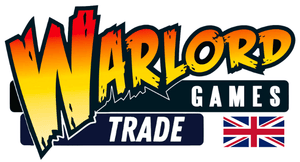Soviet Union
-
Soviet Anti-tank TeamsThe armies of the Soviet Union had many weapons at their disposal to counteract the threat of German armoured formations - from orthodox anti-tank rifles, oddball 'Molotov Cocktail' throwers and the unconventional use of dogs as living anti-tank mines. Whilst most nations were finding...
-
Soviet Army (Winter) weapons teamsInfantry weapons teams are a key component of any Bolt Action army, providing as they do great tactical flexibility for your force. Sniper teams, flamethrower teams and light mortar teams are among the most prevalent, presenting your opponent with multiple challenges to overcome. The...
-
Soviet Army weapons teamsInfantry weapons teams are a key component of any Bolt Action army, providing as they do great tactical flexibility for your force. Sniper teams, mortar teams and flamethrower teams are among the most prevalent, presenting your opponent with multiple challenges to overcome. The sniper...
-
Soviet Army support groupThis set contains: 1 x Soviet HQ 1 x Soviet Medium Machine Gun Team 1 x Soviet Medium Mortar Team Soviet HQ Like the soldiers they commanded, many Soviet officers were inexperienced and lacked training at the beginning of the Great Patriotic War. Stalin’s...
-
T34/76 Medium TankThe T-34 tank design is arguably the most important tank of all time with over 84,000 made and innovative design features. The T-34/76 first saw action in late 1941, and was a significant leap forward in tank design – a rugged, no-nonsense anatomy and...
-
T-34/85 medium tank (plastic)The T-34 series, with its sloping armour, changed the principles of tank design during the war. The sloping, angular layout of the T-34 increased the effective armour thickness and also saw a larger proportion of shells deflected away than penetrated its armour. The introduction...
-
Plastic IS-2 Heavy TankWhat do you do when you are told to upgrade an already giant metal monster that took a whole new generation of tank to actually deal with? You make it bigger and make it louder. The IS-2 is that very same beast, made as...
-
KV1/2 Plastic Box SetThe KV1/2 plastic box is absolutely crammed packed with the might of mother Russia: Enough plastic components to create one tank body and both complete turret variants (KV-1 turret and KV-2 turret)! A detailed construction booklet. A set of full-colour waterslide decals to allow...
-
Soviet Airborne SquadThe Soviets were visionaries in the development of airborne troops and tactics, first forming a brigade-sized airborne unit after successful trials in December 1932. More units followed and by June 1941 five Airborne Corps existed in the Soviet order of battle, undoubtedly the strongest...
-
Soviet Peoples Militia squad‘Popular regimentation’ or the ‘people’s militia’ (Narodnoe Opolcheniye or Opolchenie) is a Russian tradition dating back to the 16th century and a powerful part of the national heritage. In times of emergency, a militia was selected from volunteers to serve alongside the regular army...
-
Soviet NKVD squadIn 1941 the Soviet Union’s fortified borders were manned by units of the NKVD (People’s Commissariat for Internal Affairs). These units were almost entirely destroyed in the first weeks of the campaign. After this, NKVD troops were chiefly used for internal security, but could...
-
Soviet Assault Engineers squadShortages meant that Soviet formations were sparsely served when it came to transport and rear-echelon support. Pioneer detachments were a notable exception. Their expertise was too essential to do without: bridge-building, demolitions, fortification construction and minefield placement and clearance. These all required skills the...
-
Soviet Winter Infantry plastic box setWhen the German army crashed over the Russian border in 1941, Hitler was confident of a short, sharp campaign. He nearly got one, but heroic defence by the massive Soviet armies slowed the Nazi advance. It was done by the simple private soldier, "Ivan"...
-
Siberian Veterans boxed setEpitomising what Hitler referred to as the -Asiatic Hordes-, the Siberians were battle-hardened from their service in the conflict against Japan in the east. Coming as a rude shock to the forces of the Third Reich, the veteran Siberian troops fell upon the over-extended...
-
Soviet Infantry plastic box setThese are the men who fought ferociously to defend Mother Russia from the German invasion of 1941 through to the fall of Berlin in 1945. Simple peasant soldiers, they were taught to obey orders and do as they were told. Their life was hard...
-
M5 Stuart PlatoonThis new versatile plastic kit can be assembled as either an M5 Stuart, M5A1 Stuart or an E7-7 Mechanised Flamethrower, and to boot is suitable for many a Bolt Action army, including US, British, Soviet and Chinese. This platoon set gives you three of...
-
M3 Stuart PlatoonBefore the war much effort went into building light tanks, which were felt to have a role analogous to cavalry in an earlier age. Once war began these precepts were quickly brought into question, and the need for more heavily armoured and better armed...
-
M4 Sherman medium tank (plastic)The Sherman Tank was the main stay of the American army. The Break out from the Normandy beaches and the bocage could never been achieved without the armoured support. Although they had their weaknesses their impressive adaptability, firepower and large production numbers enabled the...
-
M3 StuartAs American tank designers began to recognise the outdated and obsolete nature of the M2 light tank, they realised they needed to create something new. The M3 Stuart was a direct upgrade from its predecessor, the M2 light tank, with thicker armour, modified suspension...
-
M5 StuartThis new versatile plastic kit can be assembled as either an M5 Stuart, M5A1 Stuart or an E7-7 Mechanised Flamethrower, and to boot is suitable for many a Bolt Action army, including US, British, Soviet and Chinese. The Americans favoured light tanks over armoured...









































